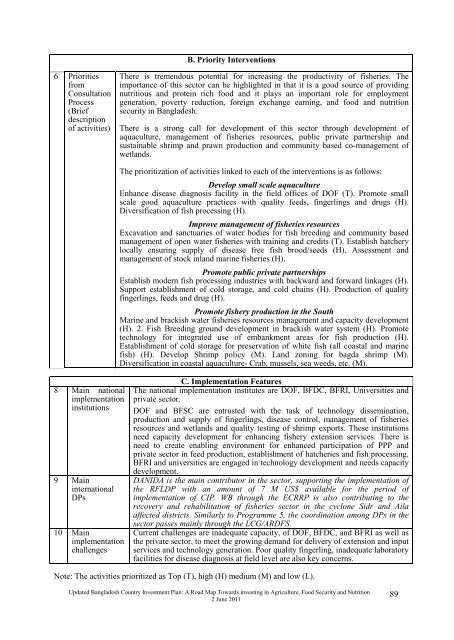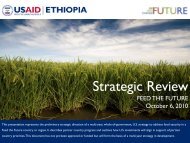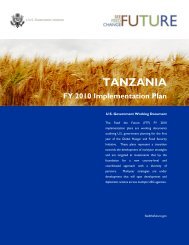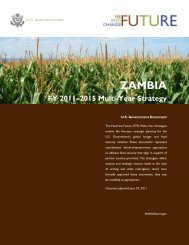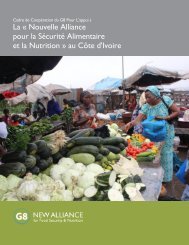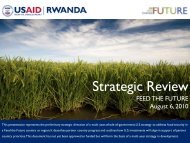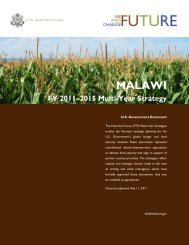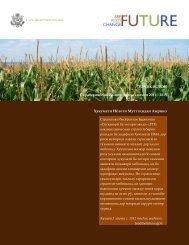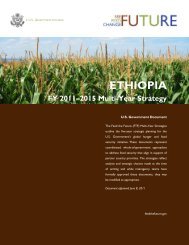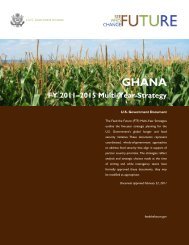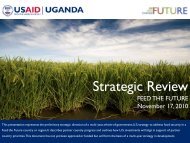Bangladesh Country Investment Plan - Feed the Future
Bangladesh Country Investment Plan - Feed the Future
Bangladesh Country Investment Plan - Feed the Future
Create successful ePaper yourself
Turn your PDF publications into a flip-book with our unique Google optimized e-Paper software.
B. Priority Interventions<br />
6 Priorities<br />
from<br />
Consultation<br />
Process<br />
(Brief<br />
description<br />
of activities)<br />
There is tremendous potential for increasing <strong>the</strong> productivity of fisheries. The<br />
importance of this sector can be highlighted in that it is a good source of providing<br />
nutritious and protein rich food and it plays an important role for employment<br />
generation, poverty reduction, foreign exchange earning, and food and nutrition<br />
security in <strong>Bangladesh</strong>.<br />
There is a strong call for development of this sector through development of<br />
aquaculture, management of fisheries resources, public private partnership and<br />
sustainable shrimp and prawn production and community based co-management of<br />
wetlands.<br />
The prioritization of activities linked to each of <strong>the</strong> interventions is as follows:<br />
Develop small scale aquaculture<br />
Enhance disease diagnosis facility in <strong>the</strong> field offices of DOF (T). Promote small<br />
scale good aquaculture practices with quality feeds, fingerlings and drugs (H).<br />
Diversification of fish processing (H).<br />
Improve management of fisheries resources<br />
Excavation and sanctuaries of water bodies for fish breeding and community based<br />
management of open water fisheries with training and credits (T). Establish hatchery<br />
locally ensuring supply of disease free fish brood/seeds (H). Assessment and<br />
management of stock inland marine fisheries (H).<br />
Promote public private partnerships<br />
Establish modern fish processing industries with backward and forward linkages (H).<br />
Support establishment of cold storage, and cold chains (H). Production of quality<br />
fingerlings, feeds and drug (H).<br />
Promote fishery production in <strong>the</strong> South<br />
Marine and brackish water fisheries resources management and capacity development<br />
(H). 2. Fish Breeding ground development in brackish water system (H). Promote<br />
technology for integrated use of embankment areas for fish production (H).<br />
Establishment of cold storage for preservation of white fish (all c oastal and marine<br />
fish) (H). Develop Shrimp policy (M). Land zoning for bagda shrimp (M).<br />
Diversification in coastal aquaculture- Crab, mussels, sea weeds, etc. (M).<br />
8 Main national<br />
implementation<br />
institutions<br />
9 Main<br />
international<br />
DPs<br />
10 Main<br />
implementation<br />
challenges<br />
C. Implementation Features<br />
The national implementation institutes are DOF, BFDC, BFRI, Universities and<br />
private sector.<br />
DOF and BFSC are entrusted with <strong>the</strong> task of technology dissemination,<br />
production and supply of fingerlings, disease control, management of fisheries<br />
resources and wetlands and quality testing of shrimp exports. These institutions<br />
need capacity development for enhancing fishery extension services. There is<br />
need to create enabling environment for enhanced participation of PPP and<br />
private sector in feed production, establishment of hatcheries and fish processing.<br />
BFRI and universities are engaged in technology development and needs capacity<br />
development.<br />
DANIDA is <strong>the</strong> main contributor in <strong>the</strong> sector, supporting <strong>the</strong> implementation of<br />
<strong>the</strong> RFLDP with an amount of 7 M US$ available for <strong>the</strong> period of<br />
implementation of CIP. WB through <strong>the</strong> ECRRP is also contributing to <strong>the</strong><br />
recovery and rehabilitation of fisheries sector in <strong>the</strong> cyclone Sidr and Aila<br />
affected districts. Similarly to Programme 5, <strong>the</strong> coordination among DPs in <strong>the</strong><br />
sector passes mainly through <strong>the</strong> LCG/ARDFS.<br />
Current challenges are inadequate capacity, of DOF, BFDC, and BFRI as well as<br />
<strong>the</strong> private sector, to meet <strong>the</strong> growing demand for delivery of extension and input<br />
services and technology generation. Poor quality fingerling, inadequate laboratory<br />
facilities for disease diagnosis at field level are also key concerns.<br />
Note: The activities prioritized as Top (T), high (H) medium (M) and low (L).<br />
Updated <strong>Bangladesh</strong> <strong>Country</strong> <strong>Investment</strong> <strong>Plan</strong>: A Road Map Towards investing in Agriculture, Food Security and Nutrition<br />
2 June 2011<br />
89


